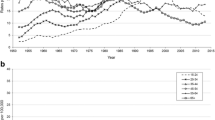Abstract
At the end of the 19th century, male suicide rates in Switzerland were as high as the respective rates in recent decades, whereas female suicide rates were distinctly lower. An age–period–cohort analysis was performed to provide more information about the genderspecific changes over the last century. Suicide mortality has been reported in Switzerland since 1876 when the standardised registration of mortality data began. The analysed data cover the period 1881–2000. The statistical analyses were based on log–linear models and data aggregated by 10–year age–intervals and 10–year periodintervals. The results indicate similar age and period effects in males and females. The estimates representing age–specific risk increase steadily with age, with intermediate plateaus in the 20s and the 50s. The period–specific estimates follow the economic cycles. The birth cohort effects are stronger in males and weaker in females. In the males' estimates, there is a peak in cohorts born around 1840 and a low in cohorts born some 60–100 years later. The estimates increased again in generations born after World War II. In females, the birth cohort estimates are low in cohorts born in the first half of the 19th century and increase until the first half of the 20th century. Birth cohort effects remain an intriguing topic in epidemiology of suicide. A better understanding of birth cohort effects might open new doors to suicide prevention.
Similar content being viewed by others
References
Ajdacic–Gross V (1999) Suizid, sozialer Wandel und die Gegenwart der Zukunft. (Suicide, social change and the presence of the future). Peter Lang, Bern
Allebeck P, Brandt L, Nordstrom P, Asgard U (1996) Are suicide trends among the young reversing – age, period and cohort analyses of suicide rates in Sweden. Acta Psychiatr Scand 93:43–48
Baca–Garcia E, Diaz–Sastre C, Garcia Resa E, Blasco H, Braquehais Conesa D, Oquendo MA, Saiz–Ruiz J, de Leon J (2005) Suicide attempts and impulsivity. Eur Arch Psychiatry Clin Neurosci 255:152–156
Barnes RA, Ennis J, Schober R (1986) Cohort analysis of Ontario suicide rates, 1877–1976. Can J Psychiatry 31:208–213
Bille–Brahe U, Jessen G (1994) The frequency of suicide in individual Danish birth cohorts, 1922–1991. Suic Life Threat Behav 24:275–281
Bopp M, Gmel G (1999) Alcohol consumption and gender in the 20th century: the case of Switzerland. Soz Praventivmed 44:211–221
Cherpitel CJ, Borges GL, Wilcox HC (2004) Acute alcohol use and suicidal behavior: a review of the literature. Alcohol Clin Exp Res 28:18S–28S
De Leo D, Evans R (2004) International suicide rates and prevention strategies. Hogrefe and Huber, Göttingen
de Moore GM, Robertson AR (1999) Suicide attempts by firearms and by leaping from heights: a comparative study of survivors. Am J Psychiatry 156:1425–1431
De Preux E, Dubois–Arber F, Zobel F (2004) Current trends in illegal drug use and drug related health problems in Switzerland. Swiss Med Wkly 134:313–321
Di Maggio C, Martinez M, Menard JF, Petit M, Thibaut F (2001) Evidence of a cohort effect for age at onset of schizophrenia. Am J Psychiatry 158:489–492
Durkheim E (2002/1930, 1897/) Le suicide. Quadrige/PUF, Paris
Fienberg SE, Mason WM (1985) Specification and implementation of age, period and cohort models. In:Mason WM, Fienberg SE (eds) Cohort analysis in social research. Springer, New York, pp 44–87
Gale CR, Martyn CN (2004) Birth weight and later risk of depression in a national birth cohort .Br J Psychiatry 184:28–33
Giuffra LA, Risch N (1994) Diminished recall and the cohort effect of major depression: a simulation study. Psychol Med 24:375–383
Glynn RJ, Bouchard GR, LoCastro JS, Laird NM (1985) Aging and generational effects on drinking behaviors in men: results from the normative aging study. Am J Public Health 75:1413–1419
Granizo JJ, Guallar E, Rodriguez–Artalejo F (1996) Age–periodcohort analysis of suicide mortality rates in Spain, 1959–1991. Int J Epidemiol 25:814–820
Gunnell D, Middleton N, Whitley E, Dorling D, Frankel S (2003) Influence of cohort effects on patterns of suicide in England and Wales, 1950–1999. Br J Psychiatry 182:164–170
Gunnell D, Middleton N, Whitley E, Dorling D, Frankel S (2003) Why are suicide rates rising in young men but falling in the elderly? A time–series analysis of trends in England and Wales 1950–1998. Soc Sci Med 57:595–611
Hagenaars JA (1990) Categorical longitudinal data. Log linear panel, trend, and cohort analysis. Sage, Newbury Park London New Delhi
Holford TR (1985) An alternative approach to statistical age–period– cohort analysis. J Chronic Dis 38:831–836
Holford TR (1991) Understanding the effects of age, period, and cohort on incidence and mortality rates. Ann Rev Pub Health 12:425–457
Jakob O (1979) Der Suizid in der Schweiz 1876–1977. Soz Praventivmed 24:21–27
Johnson RA, Gerstein DR (2000) Age, period, and cohort effects in marijuana and alcohol incidence: United States females and males, 1961–1990. Subst Use Misuse 35:925–948
Joyce PR, Oakley–Browne MA, Wells JE, Bushnell JA, Hornblow AR (1990) Birth cohort trends in major depression: increasing rates and earlier onset in New Zealand. J Affect Disord 18:83–89
Kasen S, Cohen P, Chen H, Castille D (2003) Depression in adult women: age changes and cohort effects. Am J Public Health 93:2061–2066
Kessler RC, McGonagle KA, Nelson CB, Hughes M, Swartz M, Blazer DG (1994) Sex and depression in the National Comorbidity Survey. II: Cohort effects. J Affect Disord 30:15–26
Klerman GL, Leon AC, Wickramaratne P, Warshaw MG, Mueller TI, Weissman MM, Akiskal H (1996) The role of drug and alcohol abuse in recent increases in depression in the US. Psychol Med 26:343–351
Klerman GL, Weissman MM (1989) Increasing rates of depression. JAMA 261:2229–2235
La Vecchia C, Lucchini F, Levi F, Negri E (1993) Trends in suicide mortality in Europe, 1955–89. Soz Praventivmed 38:379–397
Lavori PW, Klerman GL, Keller MB, Reich T, Rice J, Endicott J (1987) Age–period–cohort analysis of secular trends in onset of major depression: findings in siblings of patients with major affective disorder. J Psychiatr Res 21:23–35
Lester D (ed) (1994) Emile Durkheim – Le suicide – One hunderd years later. The Charles Press, Philadelphia
Lewinsohn PM, Rohde P, Seeley JR, Fischer SA (1993) Age–cohort changes in the lifetime occurrence of depression and other mental disorders. J Abnorm Psychol 102:110–120
Lloyd L, Armour PK, Smith RJ (1987) Suicide in Texas: a cohort analysis of trends in suicide rates, 1945–1980. Suic Life Threat Behav 17:205–217
Mason KO, Mason WM, Winsborough HH, Poole WK (1973) Some methodological issues in cohort analysis of archival data. Am Sociol Rev 38:242–258
Minder CE, Zingg W (1989) Die Sterblichkeitsstatistik in der Schweiz. Datenqualit der Todesursachen und der Berufsbezeichnungen. Amtliche Statistik der Schweiz, Nr. 155. Bundesamt für Statistik, Bern
Mittendorfer–Rutz E, Rasmussen F, Wasserman D (2004) Restricted fetal growth and adverse maternal psychosocial and socioeconomic conditions as risk factors for suicidal behaviour of offspring: a cohort study. Lancet 364:1135–1140
Morrell S, Page A, Taylor R (2002) Birth cohort effects in New South Wales suicide, 1865–1998. Acta Psychiatr Scand 106: 365–372
Murphy E, Lindesay J, Grundy E (1986) 60 years of suicide in England and Wales. Arch Gen Psych 43:969–976
Murphy GE, Wetzel RD (1980) Suicide risk by birth cohort in the United States, 1949 to 1974. Arch Gen Psych 37:519–523
Murphy JM, Laird NM, Monson RR, Sobol AM, Leighton AH (2000) A 40–year perspective on the prevalence of depression: the Stirling County Study. Arch Gen Psychiatry 57:209–215
Newman SC, Dyck RJ (1988) On the age–period–cohort analysis of suicide rates. Psychol Med 18:677–681
Pierce A (1967) The economic cycle and the social suicide rate. Am Sociol Rev 32:457–462
Rice JP, Neuman RJ, Saccone NL, Corbett J, Rochberg N, Hesselbrock V, Bucholz KK, McGuffin P, Reich T (2003) Age and birth cohort effects on rates of alcohol dependence. Alcohol Clin Exp Res 27:93–99
Ryder NB (1985 (1965)) The cohort as a concept in the study of social change. In:Mason WM, Fienberg SE (eds) Cohort analysis in social research. Springer, New York, pp 9–44
SAS Institute Inc. (1996) SAS for Macintosh, Version 6. 12. SAS Institute Inc., Cary, NC
Schneider B, Schnabel A, Sargk D, Maurer K, Weber B, Wetterling T (2005) Detection of alcohol consumption in suicides. Eur Arch Psychiatry Clin Neurosci 255:1–5
Simon GE, VonKorff M (1992) Reevaluation of secular trends in depression rates. Am J Epidemiol 135:1411–1422
Snowdon J, Hunt GE (2002) Age, period and cohort effects on suicide rates in Australia, 1919–1999. Acta Psychiatr Scand 105:265–270
Solomon MI, Hellon CP (1980) Suicide and age in Alberta, Canada, 1951 to 1977: A cohort analysis. Arch Gen Psych 37: 511–513
Stockard J, O’Brien RM (2002) Cohort variations and changes in age–specific suicide rates over time: explaining variations in youth suicide. Soc Forces 81:605–642
Surtees PG, Duffy JC (1989) Suicide in England and Wales 1946–1985: an age–period–cohort analysis. Acta Psychiatr Scand 79:216–223
Suvisaari JM, Haukka JK, Tanskanen AJ, Lonnqvist JK (1999) Decline in the incidence of schizophrenia in Finnish cohorts born from 1954 to 1965. Arch Gen Psychiatry 56:733–740
Takei N, Lewis G, Sham PC, Murray RM (1996) Age–period–cohort analysis of the incidence of schizophrenia in Scotland. Psychol Med 26:963–973
Trovato F (1988) Suicide in Canada: a further look at the effects of age, period and cohort. Can J Public Health 79:37–44
Warshaw MG, Klerman GL, Lavori PW (1991) The use of conditional probabilities to examine age–period–cohort data: further evidence for a period effect in major depressive disorder. J Affect Disord 23:119–129
Wickramaratne PJ, Weissman MM, Leaf PJ, et al. (1989) Age, period and cohort effects on the risk of major depression: results from five United States communities. J Clin Epidemiol 42:333–343
Author information
Authors and Affiliations
Corresponding author
Rights and permissions
About this article
Cite this article
Ajdacic–Gross, V., Bopp, M., Gostynski, M. et al. Age–period–cohort analysis of Swiss suicide data, 1881–2000. Eur Arch Psychiatry Clin Neurosci 256, 207–214 (2006). https://doi.org/10.1007/s00406-005-0627-1
Received:
Accepted:
Published:
Issue Date:
DOI: https://doi.org/10.1007/s00406-005-0627-1




